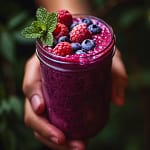How to Master Pyramid Pose (Parsvottonasana) in Yoga: A Step-by-Step Guide
Pyramid Pose is a powerful asana that primarily targets the hamstrings and shoulders. Consistent practice of this pose offers numerous benefits for your mind and body. Here are some of the key advantages you can expect:
- Improved Flexibility:: Through the consistent and deliberate elongation of your hamstrings, Pyramid Pose orchestrates a gradual amplification of your overall flexibility, enabling you to effortlessly navigate through the activities of your daily life with a newfound suppleness.
- Amplify Core Strength: By conscientiously enlisting the involvement of your core musculature while partaking in the symphony of Pyramid Pose, you embolden and stabilize your abdominal region, thus contributing to the cultivation of an impeccable alignment, unwavering posture, and steadfast equilibrium.
- Spinal Stretch: Immerse yourself in the embrace of this pose’s profound spinal voyage, as it lavishes upon your precious vertebral column an exquisite stretch, facilitating an opulent alignment of the spinal contours and orchestrating the ethereal release of accumulated tension that may have nestled within your lumbar sanctum.
- Shoulder Opening: As your graceful arms gracefully unfurl in an ethereal dance, soaring above your crown or gently enlacing themselves behind your noble back, the illustrious Pyramid Pose unravels a sanctuary of serenity within your hallowed shoulders. It tenderly caresses these oft-forgotten sentinels, emancipating them from the shackles of accumulated tension and unfurling their wings of mobility.
- Mental Clarity: As you embark upon the evocative forward bend nestled within Pyramid Pose, an enchanting inversion emerges, arousing a captivating dance of invigorating blood flow, ardently nourishing the cerebral sanctuary within your cranium. The forward bend in Pyramid Pose creates an inversion, facilitating blood flow to the brain and potentially enhancing mental clarity and focus.
Step-by-Step Instructions
Welcome to our comprehensive guide on how to master Pyramid Pose (Parsvottonasana) in yoga. In this step-by-step tutorial, we will take you through the proper form, variations, common mistakes to avoid, modifications, and the incredible benefits of this transformative yoga pose. Whether you’re a beginner or an experienced yogi, practicing Pyramid Pose can greatly enhance your flexibility and overall well-being.
Follow these step-by-step instructions to perform Pyramid Pose with proper form and alignment:
- Starting Position: Begin in Downward-Facing Dog (Adho Mukha Svanasana) with your palms pressing firmly into the mat and your hips lifted toward the ceiling.

Image by yanalya on Freepik
- Right Foot Forward: Inhale and bring your right foot forward to the inside of your right hand, placing it firmly on the ground. Your toes should be pointing forward, in line with your knee.
- Aligning the Hips: Square your hips by gently adjusting your back foot. The sole of your left foot should be flat on the mat, and your toes should be turned out slightly.

Image by yanalya on Freepik
- Straighten Your Right Leg: As you exhale, begin straightening your right leg while simultaneously lifting your torso to a standing position. Keep your hands on your hips to ensure they face forward.
- Lengthening the Spine: Inhale deeply, elongating your spine and lifting through the crown of your head. This will create space and length in your upper body.
- Forward Bend: On your next exhale, engage your core and initiate a forward bend over your right leg. As you fold forward, maintain a flat back as long as possible.
- Hands Placement: Place your hands on the floor, either on your fingertips or with your palms flat, depending on your flexibility. Find a comfortable hand position that allows you to maintain balance and stability.
- Breathing and Deepening the Stretch: Inhale to lengthen your spine, and on each exhale, gently deepen the forward bend, gradually sinking deeper into the pose. Remember to microbend your right knee to avoid locking it.
- Staying in the Pose: Remain in Pyramid Pose for about five deep breaths, allowing your body to relax and surrender into the stretch.
- Repeating on the Other Side: To maintain balance in your practice, repeat the same sequence on the left side. Step your right foot back, align your hips, straighten your left leg, and perform the forward bend.

Image by yanalya on Freepik
Pyramid Pose (Parsvottonasana) offers several variations that allow practitioners to modify the pose based on their flexibility, strength, and experience level. Here are some variations you can explore:
Variations of Pyramid Pose
- Reverse Prayer Variation: Begin in the standard Pyramid Pose position with your hands on your hips. Instead of placing your hands on the floor, bring your palms together in a prayer position behind your back. Gently press your palms together and lift your heart, deepening the stretch in your shoulders and chest.
- Twisted Pyramid Pose: Start in Pyramid Pose with your hands on the floor or on blocks. Inhale and lengthen your spine, then exhale and twist your torso to the right, placing your left hand on the outside of your right foot or on a block. Extend your right arm upward, opening your chest to the right. Hold the twist for a few breaths and then repeat on the other side.
- Revolved Pyramid Pose: From Pyramid Pose, place your left hand on the floor or a block on the outside of your right foot. Inhale and reach your right arm straight up toward the ceiling, twisting your torso to the right. Keep your hips square and your gaze upward or toward your right hand. Hold the pose for a few breaths and switch sides.
- Pyramid Pose with Bound Hands: Start in Pyramid Pose and interlace your fingers behind your back. Extend your arms and lift them away from your body as much as possible, opening your chest and shoulders. Maintain a strong connection between your hands and actively engage your core to support your balance.
- High Lunge to Pyramid Pose Flow: Begin in a high lunge position with your right foot forward. On an exhale, bring your hands to the floor or blocks on either side of your front foot. Inhale as you lift your left leg off the ground, transitioning into Pyramid Pose. Hold for a few breaths, then inhale to lift your torso and return to a high lunge. Repeat the flow several times, synchronizing your breath with the movements.

Image by yanalya on Freepik
Remember to listen to your body and choose the variation that suits your needs. It’s always recommended to practice under the guidance of a qualified yoga instructor to ensure proper alignment and prevent injuries.
Common Mistakes to Avoid in Pyramid Pose
To ensure you get the most out of your Pyramid Pose practice and avoid potential pitfalls, it’s important to be aware of common mistakes. Here are some common mistakes to avoid when performing Pyramid Pose (Parsvottonasana):
- Narrow Stance: Make sure your feet are hip-width apart, like train tracks, rather than having them too close together. This wider stance helps with balance and stability.
- Rounded Back: While coming into the forward bend, it’s crucial to maintain a flat back as much as possible. Avoid rounding your spine excessively, especially when reaching your maximum extension.
- Grasping Shins: Resist the temptation to grab onto your shins with your hands. Instead, focus on keeping your hands on the floor, on blocks, or clasped behind your back. This ensures proper alignment and allows for a deeper stretch.
- Locked Knee: Avoid hyperextending or locking your knee in Pyramid Pose. Keep a microbend in your front knee to protect the joint and maintain stability.
- Lack of Hip Squareness: Pay attention to the alignment of your hips. Both hip points should face towards the front of the mat to maintain proper alignment and prevent strain on the hips and lower back.
Remember to listen to your body and make modifications as needed. If you experience any pain or discomfort, it’s important to ease off and adjust your position. Regular practice and mindful execution will help you progress in Pyramid Pose and reap its many benefits.
Benefits of Pyramid Pose
Pyramid Pose (Parsvottonasana) offers numerous benefits for the mind and body. Here are some of the key advantages you can expect from practicing this yoga pose:
- Hamstring Stretch: Pyramid Pose provides a deep stretch to the hamstrings, which are the muscles located at the back of your thighs. Consistent practice can help improve hamstring flexibility, making it beneficial for athletes, runners, and anyone looking to increase their range of motion in the legs.
- Hip Opening: As you fold forward in Pyramid Pose, it stretches and opens the hips. This can be especially beneficial for individuals who spend long hours sitting or have tight hips due to sedentary lifestyles. Opening the hips can improve posture, relieve lower back tension, and enhance overall mobility.
- Spine Extension: The elongated position of the spine in Pyramid Pose helps improve posture and strengthen the back muscles. It creates length and space between the vertebrae, promoting better spinal alignment and reducing the risk of back pain.
- Improved Balance and Stability: Maintaining balance in Pyramid Pose requires concentration and engagement of the core muscles. Regular practice can enhance your balance and stability, which can be beneficial for various physical activities and sports.
- Mind-Body Connection: Like many yoga poses, Pyramid Pose encourages mindfulness and deep breathing. As you focus on your breath and the sensations in your body, it promotes a sense of calm and relaxation. This mind-body connection can help reduce stress, improve mental clarity, and promote overall well-being.

Image by yanalya on Freepik
Remember, it’s important to approach Pyramid Pose with awareness and listen to your body. If you have any pre-existing conditions or injuries, it’s advisable to consult with a qualified yoga instructor or healthcare professional before attempting this yoga pose.
Frequently Asked Questions about Pyramid Yoga Pose
Can Pyramid Pose help improve flexibility in the hamstrings?
Yes, Pyramid Pose can be beneficial for improving flexibility in the hamstrings. The pose involves a deep stretch in the back leg, which helps lengthen and loosen the hamstrings over time.
Is it necessary to warm up before practicing Pyramid Pose?
Yes, warming up the body before attempting Pyramid Pose is recommended. This helps prepare the muscles for the stretch and reduces the risk of injury. Engaging in gentle movements, such as stretching or a short yoga sequence, can effectively warm up the body.
Can beginners practice Pyramid Pose?
Yes, beginners can practice Pyramid Pose. However, it’s essential to start with modifications and gradually work towards a deeper expression of the pose. Beginners should focus on proper alignment and listen to their body’s limits.
How long should one hold Pyramid Pose?
The duration of holding Pyramid Pose can vary depending on individual comfort and experience. Initially, holding the pose for 30 seconds to a minute is a good starting point. As flexibility increases, the duration can be extended.
Are there any precautions or contraindications for practicing Pyramid Pose?
While Pyramid Pose is generally safe for most individuals, it may not be suitable for those with certain conditions or injuries. People with hamstring injuries, lower back issues, or high blood pressure should approach the pose with caution or seek guidance from a qualified yoga instructor.




